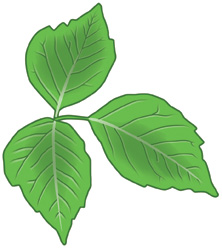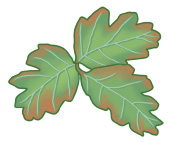Poison Ivy or Poison Oak Rash
You have a rash and itching. This is a delayed reaction to the oils of a poisonous plant. It was likely poison ivy or poison oak. An oil called uroshiol is found in both poison ivy and poison oak. It's what causes the rash. Healthcare providers can't always tell which plant caused the rash unless you know for sure which plant you came into contact with.
You likely came in contact with poison ivy or poison oak during the 3 days before your symptoms started. You are more likely to have the rash if you had this rash before. It may take 2 to 3 weeks before the rash appears if you have never had a rash from either plant before.
Your skin will become red and itchy. Small blisters may appear. These can break and leak a clear yellow fluid. This fluid can't cause a rash in others who touch it. The reaction usually starts to go away after 1 to 2 weeks. But it may take 4 to 6 weeks to fully go away.
 |
| Poison ivy leaves |
 |
| Poison oak leaves |
Home care
Follow these guidelines when caring for yourself at home:
-
The plant oils still on your skin or clothes can be spread to other places on your body. They can also be passed on to other people and cause a similar reaction. That’s why it’s important to wash all of the plant oils off your skin and any clothes that may have been exposed. Wash all clothes that you were wearing. Use hot water with regular laundry detergent. Dogs and cats that get into poison ivy may not get a rash, but the plant oils may be on their fur. Be sure to wash your pets, too.
-
Don't use over-the-counter antibiotic creams on the rash skin. Examples are neomycin and bacitracin. These may make the rash worse.
-
Stay away from anything that heats up your skin. This includes hot showers and baths, and direct sunlight. These can make itching worse.
-
Put a cold compress on areas that are leaking (weeping) and on blistered areas. Do this for 30 minutes, 3 times a day. To make a compress, dip a washcloth in a mixture of 1 pint of cold water and 1 packet of astringent (aluminum acetate) or oatmeal bath powder (colloidal oatmeal, sold in pharmacies). Keep the solution in the refrigerator for future use.
-
You may take a lukewarm bath if large areas of your skin are affected. Add colloidal oatmeal to the water. Or you can add 1 cup of baking soda to the water.
-
Use hydrocortisone cream for redness and irritation for a rash in a smaller area. But don’t use this if another medicine was prescribed. For severe itching, put an ice pack on the area. To make an ice pack, put ice cubes in a plastic bag that seals at the top. Wrap the bag in a clean, thin towel or cloth. Never put ice or an ice pack directly on the skin. Over-the-counter lotions that have calamine may also be helpful.
-
You can also use an oral antihistamine medicine with diphenhydramine for itching, unless another medicine was prescribed. This medicine may make you sleepy. So be cautious when using this medicine during the daytime. Don’t use medicine that has diphenhydramine if you have glaucoma. Also don't use it if you are a man with trouble urinating because of an enlarged prostate. Antihistamines with loratadine may cause less drowsiness. They may be a good choice for daytime use.
-
For severe cases, your provider may prescribe oral steroids such as prednisone. Always take these exactly as prescribed.
Follow-up care
Follow up with your healthcare provider, or as advised. Call your provider if your rash gets worse or you are not starting to get better after 1 week of treatment.
Call 911
Call 911 if you have trouble breathing or swallowing. Or if you have severe swelling in your face, eyelids, mouth, throat, or tongue.
When to get medical advice
Call your healthcare provider right away if any of the following occur:
-
Spreading facial rash with swelling of mouth or eyelids
-
Rash that spreads to the groin and causes swelling of the penis, scrotum, or vaginal area
-
Trouble urinating because of swelling in the genital area
Also call your provider right away if you have signs of infection in the areas of broken blisters:
-
Spreading redness
-
Pus or fluid draining from the blisters
-
Yellow-brown crusts form over the open blisters
-
Fever of 100.4°F (38ºC) or higher, or as directed by your healthcare provider
Online Medical Reviewer:
L Renee Watson MSN RN
Online Medical Reviewer:
Michael Lehrer MD
Online Medical Reviewer:
Rita Sather RN
Date Last Reviewed:
3/1/2022
© 2000-2024 The StayWell Company, LLC. All rights reserved. This information is not intended as a substitute for professional medical care. Always follow your healthcare professional's instructions.